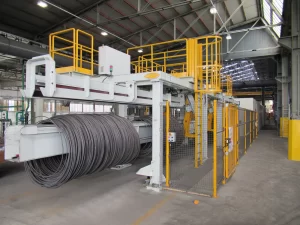Streamlining Operations: A Deep Dive into Automatic Wire Rod Compacting and Strapping Machines
Handling and packaging large steel wire coils or wire rod bundles presents significant logistical challenges in the metals industry. Their bulk and weight demand efficient, secure, and often automated solutions for storage and transport. An automatic wire coil compacting and strapping machine addresses these needs directly, transforming loose or bulky coils into tightly secured, manageable units. This technology is crucial for improving throughput, ensuring safety, and optimizing downstream logistics.
1. The Automated Compacting and Strapping Process Explained
Understanding the workflow provides insight into the machine's value:
- Infeed: Wire rod bundles or coils are typically fed into the machine via conveyor systems or C-hooks, often integrated with upstream production lines. Proper alignment at this stage is crucial for consistent results.
- Compaction: The coil enters the compacting station. Here, significant force is applied to reduce the overall volume. This is often achieved using powerful hydraulic pistons pressing platens against the coil, applying extreme pressure from multiple directions to create a denser, more stable package. Some designs might utilize heavy-duty rollers.
- Strapping: Once compacted to the desired dimensions, the bundle is transferred or held in place for the automated strapping cycle. Depending on the configuration, multiple strapping heads apply bindings circumferentially at predetermined positions. Common materials include high-tensile steel straps or durable PET straps. The straps are automatically tensioned, sealed (often using friction-weld or notch seals), and cut.
- Outfeed: The securely compacted and strapped coil is then discharged from the machine, ready for labeling, weighing, storage, or direct shipment.
2. Key Technical Specifications and Considerations
When evaluating or operating these machines, several parameters are critical:
- Coil Dimensions:
- Inner Diameter (ID) Range
- Outer Diameter (OD) Range
- Coil Width/Height Range
- Maximum Coil Weight
- Compaction System:
- Compaction Force (e.g., in tons or kN)
- Press Platen Size/Configuration
- Hydraulic System Pressure
- Strapping System:
- Strap Type Compatibility (Steel, PET)
- Strap Width & Thickness Range
- Number of Straps Applied per Coil
- Strapping Head Type (e.g., friction weld, notch seal)
- Adjustable Strap Tension Control
- Performance:
- Cycle Time (seconds per coil)
- Overall Throughput (coils per hour)
- Control & Automation:
- PLC Brand and Model (e.g., Siemens, Allen-Bradley)
- HMI (Human-Machine Interface) for settings and diagnostics
- Level of Automation (stand-alone vs. integrated line control)
- Utilities:
- Power Requirements (Voltage, Phase, Frequency)
- Compressed Air Consumption (if applicable)

wire pay off systems 1 jpg 3. Operational Insights: Maximizing Performance and Reliability
From hands-on experience, optimizing the performance of automatic wire rod compactors and strappers involves several key areas:
- Preventative Maintenance: Regular checks on hydraulic systems (leaks, fluid levels), strapping heads (wear parts, cleanliness), sensors, and moving parts are essential to prevent unexpected downtime. Strap feeding mechanisms, in particular, require consistent attention.
- Operator Training: Properly trained operators understand how to manage different coil sizes, adjust settings correctly via the HMI, perform basic troubleshooting (like clearing strap jams), and recognize warning signs of potential issues.
- Strap Quality: Using consistently high-quality strapping material (whether steel or PET) is vital. Variations in strap thickness, width, or camber can lead to feeding problems or inconsistent seal quality.
- Integration Matters: Ensuring smooth handoffs from upstream processes (like coilers) and to downstream systems (conveyors, weighing stations) prevents bottlenecks and maximizes overall line efficiency. Proper sensor placement and logic programming are key.
- Coil Consistency: While machines handle a range, variations in incoming coil density or shape can sometimes affect the final compacted dimensions or strap placement. Addressing upstream inconsistencies can improve packaging quality.
4. Benefits Beyond Basic Volume Reduction
The advantages extend well beyond simply making coils smaller:
- Enhanced Safety: Automating the compaction and strapping process significantly reduces manual handling of heavy, potentially unstable coils, minimizing risks of strains, crushes, or other injuries.
- Improved Space Utilization: Denser, uniformly shaped bundles allow for more efficient use of warehouse space and maximize payload capacity in trucks or shipping containers.
- Product Integrity: Tightly applied straps ensure secure handling throughout the supply chain, preventing coil loosening, unwinding, or damage during transit.
- Operational Efficiency: These machines offer high throughput, drastically reducing the labor and time required compared to manual or semi-automatic methods.
- Consistency: Automated systems deliver repeatable compaction and strapping quality, ensuring every package meets specifications.
- Cost Savings: Reduced labor costs, optimized shipping and storage, and minimized product damage contribute to a lower total cost of operation.
wire winding 5. Integration into the Modern Production Line
Automatic wire rod compacting and strapping machines rarely operate in isolation. They are typically a key component in a larger automated system. Integration with upstream wire drawing or rolling mills, coilers, and downstream conveying, labeling, weighing, and warehouse management systems (WMS) creates a seamless flow from production to final dispatch. Advanced systems might incorporate data logging for quality control and traceability.
In conclusion, automatic wire rod compacting and strapping machines are indispensable assets in the modern metals industry. They provide a robust, efficient, and safe solution for preparing wire rod and coils for storage and shipment, delivering significant gains in productivity, cost-effectiveness, and logistical optimization. Investing in the right automated system, backed by proper maintenance and operation, is key to staying competitive.
More wire coil packing machine:


